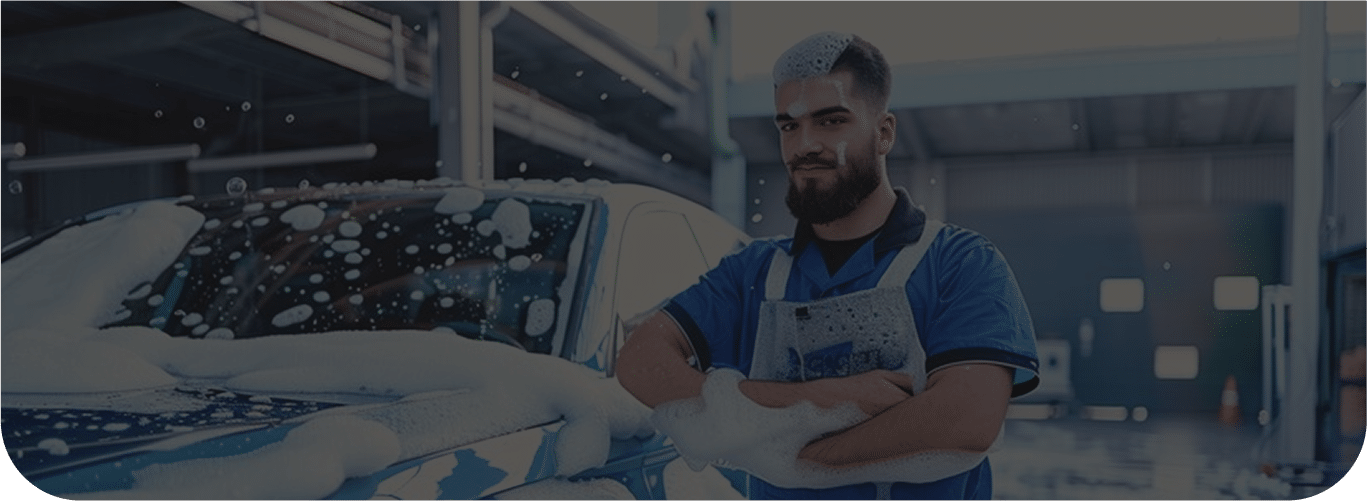Table of Contents
When it comes to maintaining the cleanliness and appearance of your vehicle, choosing the right washing method is crucial. Two popular options are wet wash and dry wash. Each has its own set of advantages and disadvantages, impacting various aspects of vehicle maintenance.
Understanding the Basics: Dry Wash vs Wet Wash
What is a Dry Wash?
A dry wash involves cleaning your vehicle without using water. Instead, it relies on specialized cleaning agents and microfiber cloths to remove dirt and grime from the vehicle’s surface. This method is often chosen for its convenience and water-saving benefits.

What is a Wet Wash?
A wet wash involves using water, soap, and other cleaning agents to wash your vehicle. This method can be performed manually or through automated systems. Wet washes are known for their thoroughness in removing a wide range of contaminants/dirt from the vehicle’s surface.

Potential Drawbacks of Dry Washing
- Cleaning Efficiency: Dry washes often leave residues and may not effectively remove stubborn dirt and grime.
- Chemical Use: The chemicals used can be harsh on the vehicle’s paint and potentially harmful to the environment and user’s health.
- Surface Damage: The abrasive nature of dry-cleaning agents can cause micro-scratches, degrading the vehicle’s paint over time.
- High Long-Term Costs: Frequent purchases of dry wash chemicals can add up, increasing long-term costs.
- Limited Effectiveness: Dry washes are less effective after exposure to mud, heavy rains, or off-road conditions.
Advantages of Wet Washing Your Vehicle
- Superior Cleaning: Wet washes effectively remove all types of dirt, grime, and contaminants, providing a thorough clean that enhances the vehicle’s appearance and longevity.
- Paint and Surface Protection: Properly regulated wet wash systems are gentle on the vehicle’s paint, reducing the risk of scratches and maintaining the vehicle’s aesthetic and resale value.
- Comprehensive Maintenance: Wet washes often include a detailed inspection of the vehicle, identifying potential issues early.
- Customer Satisfaction: Customers generally prefer the thoroughness of wet washes, leading to higher satisfaction and repeat business.

How BlueVerse Solves Common Vehicle Washing Problems
BlueVerse’s advanced wet wash technology addresses the key issues associated with both dry and wet washing methods. Here’s how:
What We Do
At BlueVerse, we deliver a high-quality vehicle wash with a 96% reduction in water consumption and cost. Our innovative technology ensures your vehicle gets the best possible care while preserving precious water resources.
How We Do It
Zero Capex (Pay-per-Wash)
No initial capital expenditure is required; you pay only for each wash.
High-Quality Wash in Less Than 5 Minute
Our automated systems provide a thorough clean in less than 5 minutes.
98% Water Recovery (Recycle, Reuse, Reduce)
Advanced systems recycle up to 98% of the water used, drastically reducing water wastage.
IoT Enabled and ESG Dashboard
Monitor and manage the entire process through our IoT-enabled systems and ESG (Environmental, Social, and Governance) dashboards.
Watch and Learn – https://youtu.be/n4YhvcrB21EEffluent Treatment Plant (ETP)
Our ETP meets Central Pollution Control Board (CPCB) standards, ensuring environmentally safe disposal.
Watch How – https://youtu.be/W3HR5g-HeAg15 to 55 KLD ETP Module Capacity
We offer scalable solutions with module capacities ranging from 15 to 55 kiloliters per day.
Plug and Play Installation
Our systems are easy and quick to install.
Customer Satisfaction Index > 95%
We achieve high customer satisfaction through efficient and effective cleaning.
BlueVerse Wet Wash vs. Dry Wash: Comparative Analysis
| Criteria | BlueVerse Wet Wash | Dry Wash |
| Cleaning Efficiency | High – Effectively removes dirt, grime, and stains. | Low – Often leaves residues and may not remove all contaminants. |
| Time Required | Fast (5 to 7 minutes) | Moderate (15-20 minutes) |
| Environmental Impact | Conserves water with advanced systems (up to 98% reuse). | Low water usage but uses chemicals which can be harmful. |
| Cost | No Capex cost. Opex cost only and economical over time with reuse. | Lower initial cost but frequent chemical purchases needed. |
| Effect on Vehicle Paint | Gentle on paint when proper pressure is maintained. | Can be abrasive and cause micro-scratches over time. |
| Dirt and Contaminant Removal | Highly effective against mud, oil, and bird droppings. | Less effective on heavy dirt and stains. |
| Suitability for Different Conditions | Suitable for all conditions, especially after muddy or rainy drives. | Less effective in removing mud and tough stains. |
| Maintenance and Upkeep | Requires regular maintenance of water recycling systems. | Frequent need to restock cleaning agents and cloths. |
| Impact on Vehicle Longevity | Extends vehicle lifespan by thoroughly cleaning and reducing corrosion. | May not prevent buildup of corrosive substances. |
| Health and Safety | Safe with minimal chemical use; prevents slipping hazards. | Chemical exposure can be hazardous to users and environment. |
| Customer Perception | Preferred by customers for thoroughness and quality results. | Viewed as a quick fix, not a thorough cleaning method. |
| Availability of Services | Widely available with numerous automated options. | Increasing but limited by availability of dry wash agents. |
| Long-Term Benefits | Promotes regular maintenance and detailed inspection opportunities. | Short-term convenience, long-term negative impact on paint quality. |
| Customer Satisfaction Index (CSI) Score | High – 85% to 95% | Moderate – 60% to 75% (to be verified) |
Conclusion
Opting for a wet wash over a dry wash for your vehicle is the smarter choice for your vehicle’s longevity. While dry wash might seem convenient and water-saving at first glance, it falls short in cleaning efficiency and can cause damage to your vehicle. On the other hand, wet wash methods, especially those with advanced water recycling systems, deliver thorough cleaning, protect vehicle surfaces and promote environmental sustainability. For a truly clean and well-maintained vehicle, wet wash is undeniably the superior option.
BlueVerse’s wet wash technology solves common vehicle washing problems, providing a high-quality, efficient, and eco-friendly solution that recycles & reuses 98% of water, thus aligns with sustainable development goals. By choosing BlueVerse, you not only maintain your vehicle’s appearance and longevity but also contribute to a more sustainable future.
Trust us, your vehicle—and the environment—will thank you.



